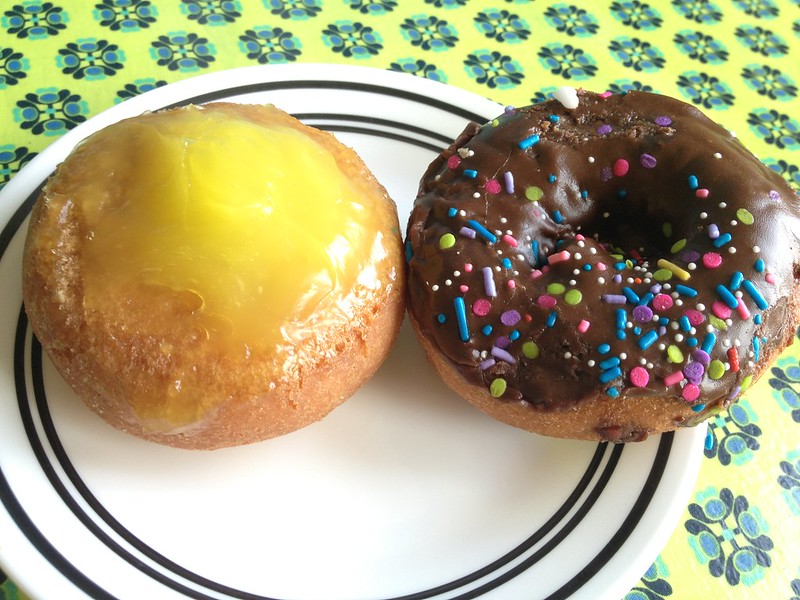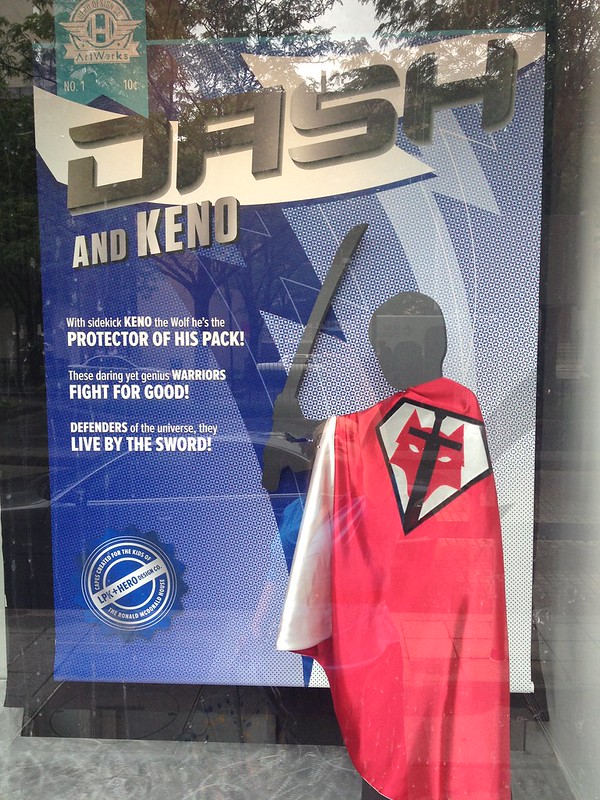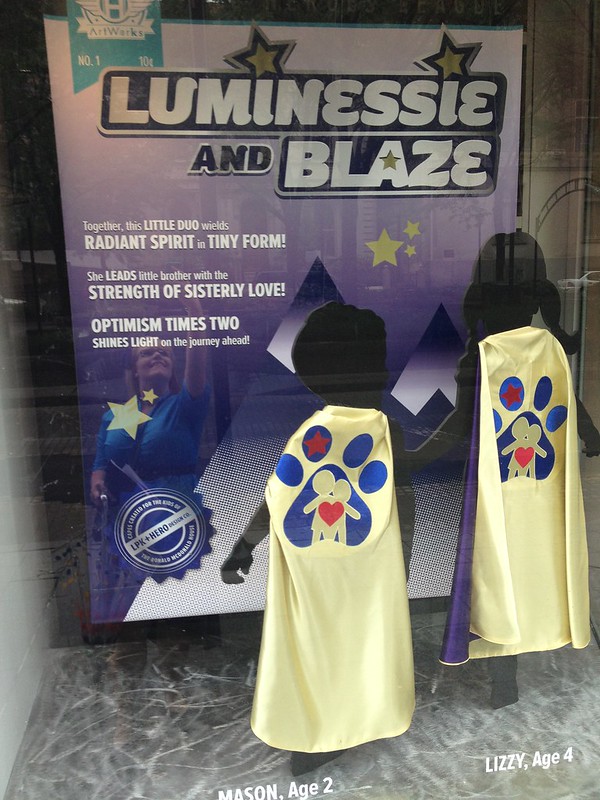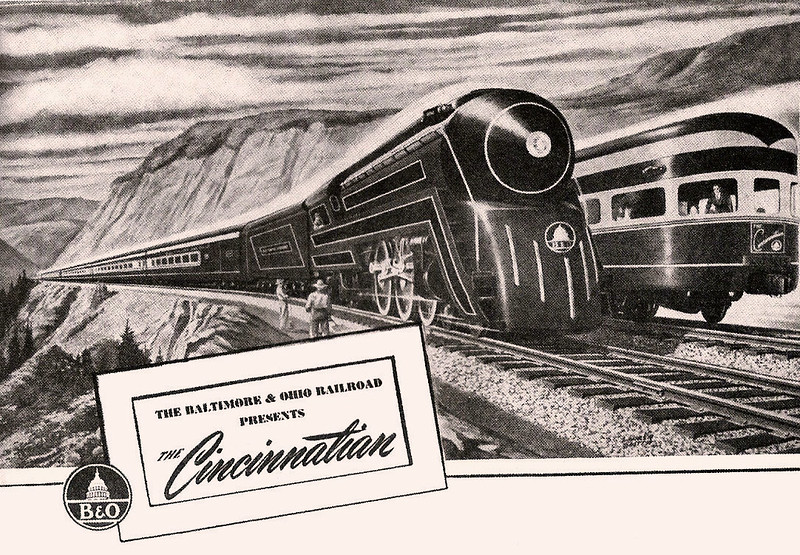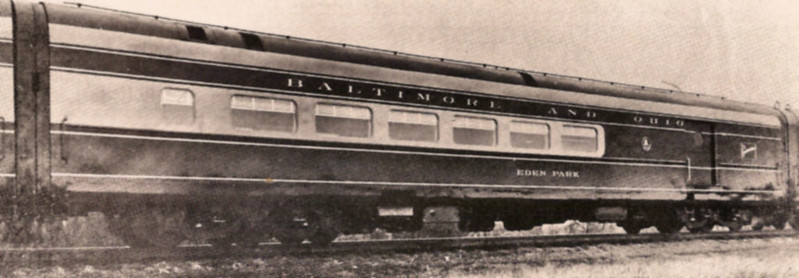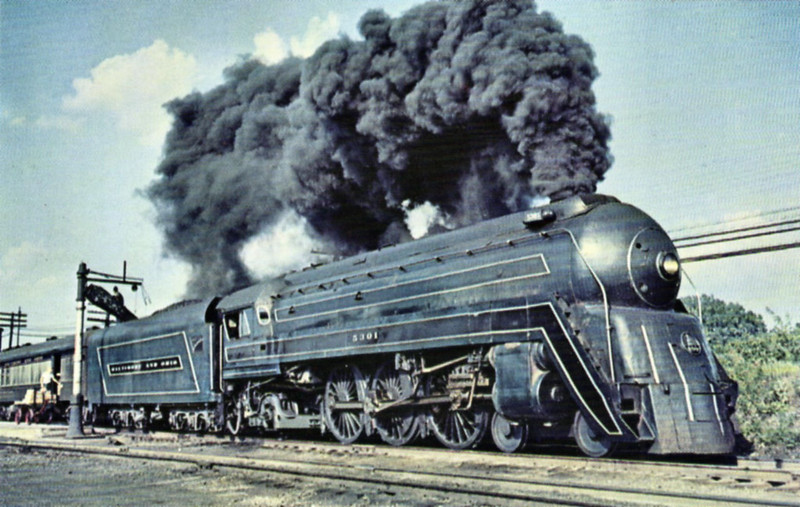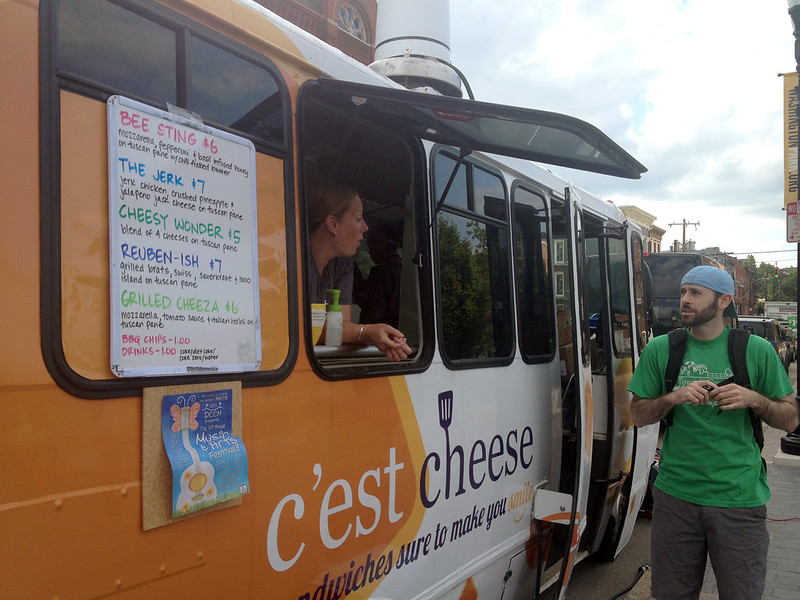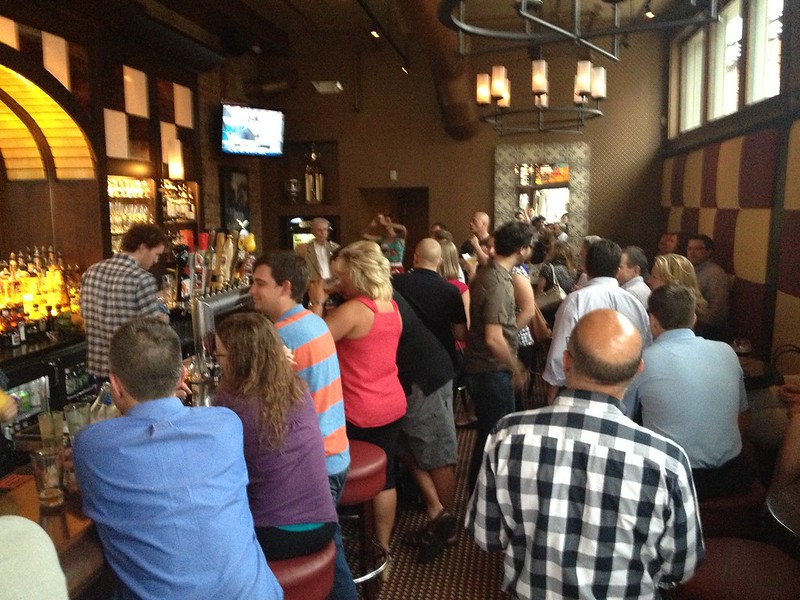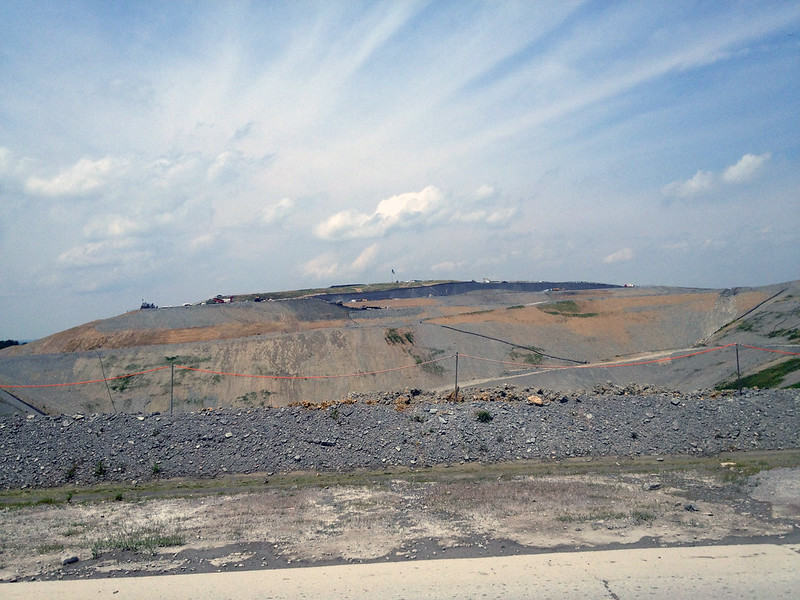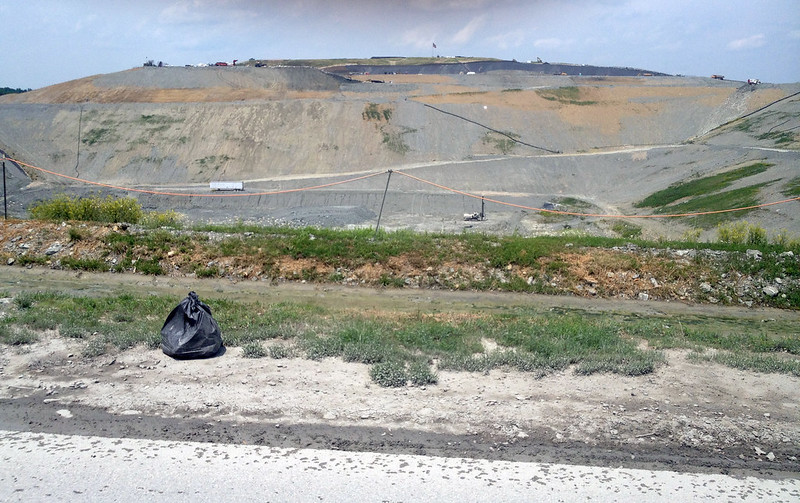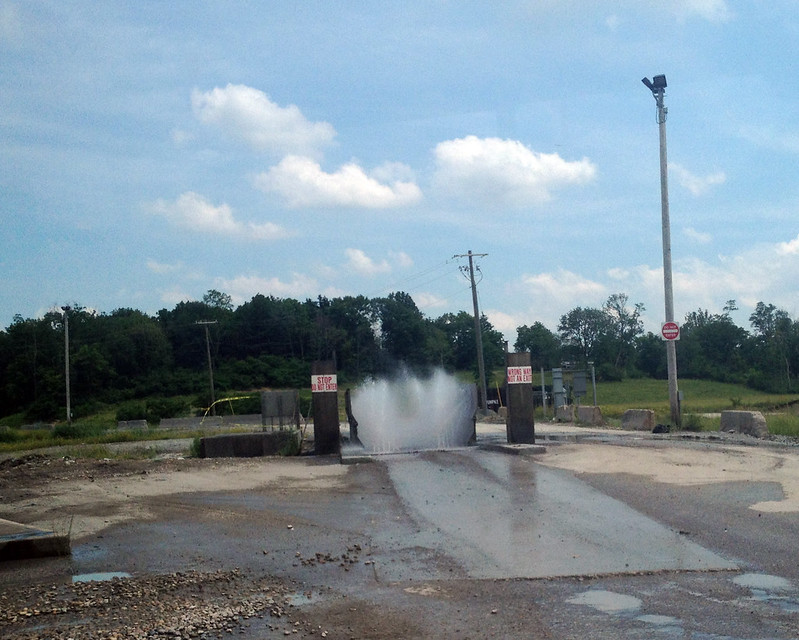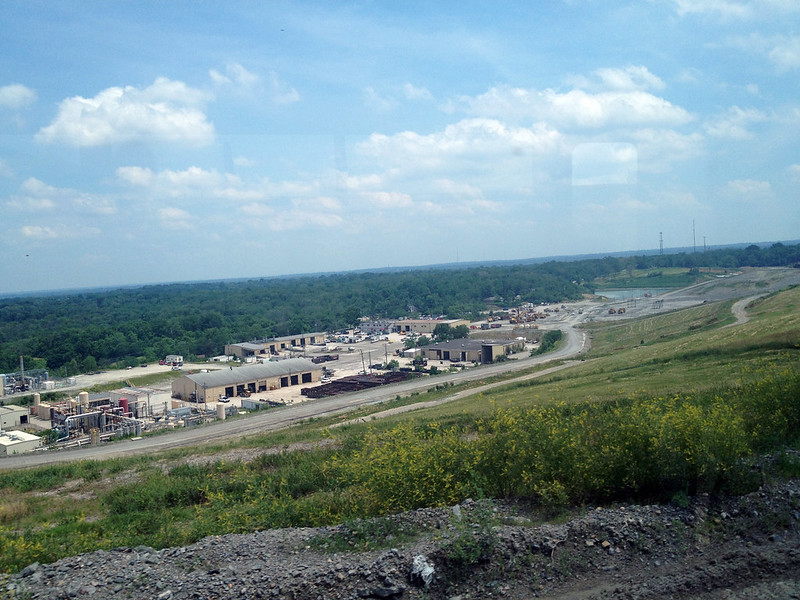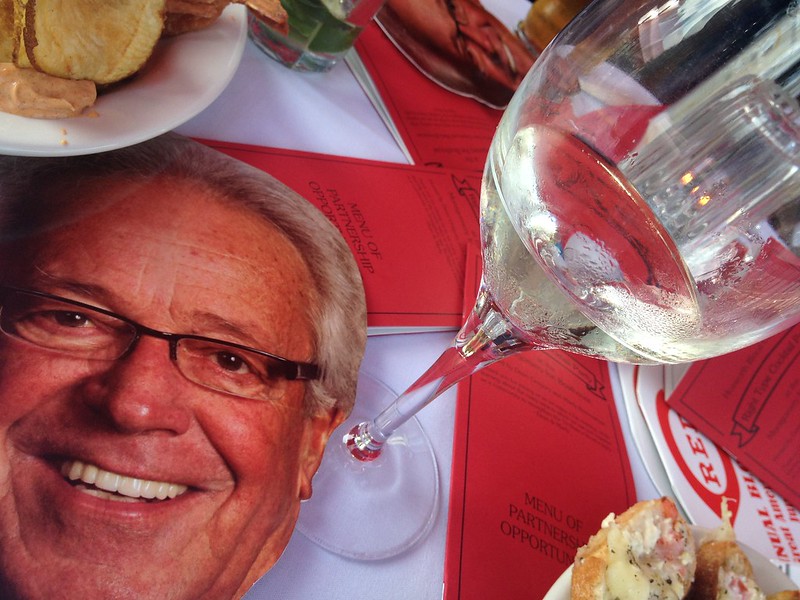The go-to treat for celebrating a birth is the obligatory cake, or in some cases, a birthday pie. Lucky for me, my friend Maureen introduced me to a third option: birthday donuts.
The surprise began with a non-descript white box sitting on the counter. My first thought: "Great. An entire cake for me to eat." Sure, cake is tasty, but not when there's expectations involved. Upon lifting the lid, this is what I found:
A giant box of donuts. Mind you, these were not just any donuts. These were the coveted Holtman's Donuts. Something delectable is happening in the bakery that originated in Loveland. Fluffy, generously frosted and uniquely flavored donuts of every shape and size are being cranked out of their kitchen. Ever since word spread of Holtman's opening a shop at 13th and Vine Street in OTR this August, these donuts have become a sought-after jewel for urban dwellers.
I certainly tasted what I had been missing. Out of the gigantic box, my favorite was the lemon jelly (which is my favorite flavor from any donut shop.) The iced donuts with sprinkles were a classic second. The maple frosted donut and coconut frosted donut were both welcome additions, as was the rectangular Boston Cream.
Friends, next time, when faced with the choice of a birthday cake; remember the breakfast-friendly alternative: Holtman's Donuts. It's a variety of sharable sweets that's the gift which keeps on giving!
LPK CAPES
Downtown design agency, LPK, is known for their creative window displays overlooking Piatt Park. Their most recent one caught my eye, which features a series of super hero capes designed by children. I began telling my friends to check out the "LPKape" display, and later learned this was much more than a creative spread for their offices.
LPK partnered with Hero Design Company, a project of Artworks, which paired the agency with Ronald McDonald House. Five children worked with design teams who helped them find their Superman within. Each group created a heroic concept and outfit based around each child's personal strengths and challenges faced with their medical hardships.
LPK partnered with Hero Design Company, a project of Artworks, which paired the agency with Ronald McDonald House. Five children worked with design teams who helped them find their Superman within. Each group created a heroic concept and outfit based around each child's personal strengths and challenges faced with their medical hardships.
B&O RAILROAD: THE CINCINNATIAN
One of the first streamlined passenger trains after World War II ran none other than in the Queen City. In 1947, The Cincinnatian began services on the B&O Railroad transporting people between Cincinnati and Baltimore, and later, Cincinnati and Detroit. This high-speed, luxury train traveled at a whopping 36mph; the journey averaging around 12 hours one way.
These state-of-the-art iron horses were a sleek blue and grey paint scheme and featured new commodities such as air conditioning and reclining seats. A pair of five-car trains were built for The Cincinnatian, each with a lounge, three coaches with a 176 passenger capacity, an observation car, dining room, and stainless steel kitchen. What made this train even more special was that each of the railcars were named after one of Cincinnati's neighborhoods:
The Hyde Park and Eden Park cars housed the lounge, buffet, air conditioning equipment, and the bathrooms.
The six passenger coach cars paid homage to Walnut Hills, College Hill, Winton Place, Indian Hill, Oakley, and Norwood. Later, replacement cars that were created were named Price Hill and Avondale.
The observation cars were named Fountain Square and Peebles Corner.
The Cincinnatian stopped operating in 1971 after Amtrak began service. The railcars have since been used for scrap with only a few images preserving their legacy.
These state-of-the-art iron horses were a sleek blue and grey paint scheme and featured new commodities such as air conditioning and reclining seats. A pair of five-car trains were built for The Cincinnatian, each with a lounge, three coaches with a 176 passenger capacity, an observation car, dining room, and stainless steel kitchen. What made this train even more special was that each of the railcars were named after one of Cincinnati's neighborhoods:
The Hyde Park and Eden Park cars housed the lounge, buffet, air conditioning equipment, and the bathrooms.
The six passenger coach cars paid homage to Walnut Hills, College Hill, Winton Place, Indian Hill, Oakley, and Norwood. Later, replacement cars that were created were named Price Hill and Avondale.
The observation cars were named Fountain Square and Peebles Corner.
The Cincinnatian stopped operating in 1971 after Amtrak began service. The railcars have since been used for scrap with only a few images preserving their legacy.
CINCINNATI'S BIG CHEESE: C'EST CHEESE FOOD TRUCK
Bringing a smile to everyone's face, Emily Frank, owner of C'est Cheese, serves up gooey, gourmet grilled cheese from a four-wheeled kitchen: her food bus.
That's right, a food bus. While Cincinnati is saturated with food trucks, C'est Cheese hits the streets in their modified public transit unit. They even have a bus schedule to track when and where Emily will be serving up food next!
C'est Cheese is another innovative start-up funded through Cincinnati micro-lender, Bad Girl Ventures. For ten weeks, Emily attended a business bootcamp where she and 100 other women competed for a $25,000 loan. And now, she's living her dream as the "big cheese" business owner after spending many years in the corporate world of Chicago.
On the menu, customers will find over 20 original sandwiches, with each of the names honoring someone important in Emily's journey. The most popular is The Bee Sting, which features Mozzarella cheese, pepperoni, and basil-infused honey, grilled with chili flake butter. The newest additions to the menu include The Reuben-ish, stuffed with mozzerella, saurkraut, and bratwurst; The Jerk, stuffed with mozzarella and zesty jerk chicken; and the Indian-inspired Bollywood, a potato samosa and mint chutney with melted cheese.
In addition to serving up cheesy goodness, Emily is also the President of the Cincinnati Food Truck Association, which helps with advancements in organization and city involvement with the Queen City's squad of 23+ food trucks.
C'est Cheese is out and about in the tri-state all week long and is available for private catering. Keep an eye out for this delightful food bus rolling into a neighborhood near you!
That's right, a food bus. While Cincinnati is saturated with food trucks, C'est Cheese hits the streets in their modified public transit unit. They even have a bus schedule to track when and where Emily will be serving up food next!
C'est Cheese is another innovative start-up funded through Cincinnati micro-lender, Bad Girl Ventures. For ten weeks, Emily attended a business bootcamp where she and 100 other women competed for a $25,000 loan. And now, she's living her dream as the "big cheese" business owner after spending many years in the corporate world of Chicago.
On the menu, customers will find over 20 original sandwiches, with each of the names honoring someone important in Emily's journey. The most popular is The Bee Sting, which features Mozzarella cheese, pepperoni, and basil-infused honey, grilled with chili flake butter. The newest additions to the menu include The Reuben-ish, stuffed with mozzerella, saurkraut, and bratwurst; The Jerk, stuffed with mozzarella and zesty jerk chicken; and the Indian-inspired Bollywood, a potato samosa and mint chutney with melted cheese.
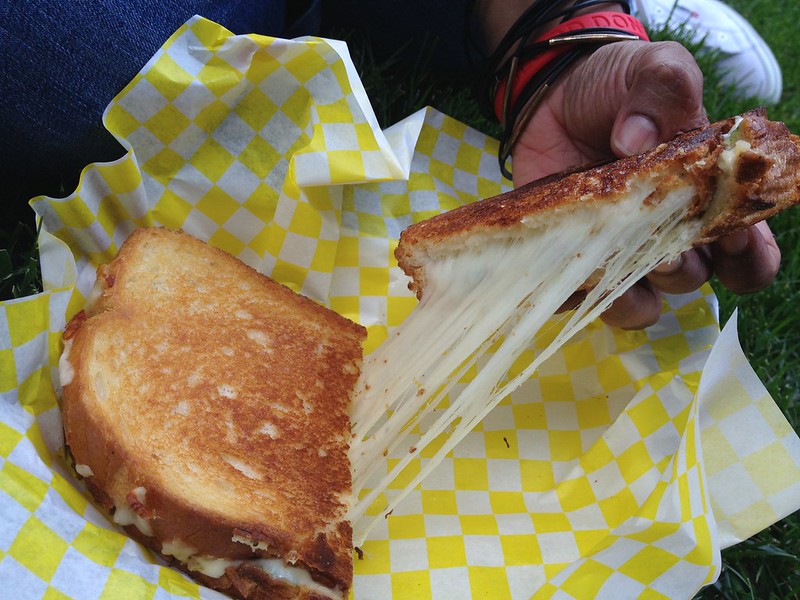 |
| The Bollywood |
 |
| The Jerk |
 |
| The Reuben-ish |
 |
| The Bad Girl with brie, honey, and raspberries |
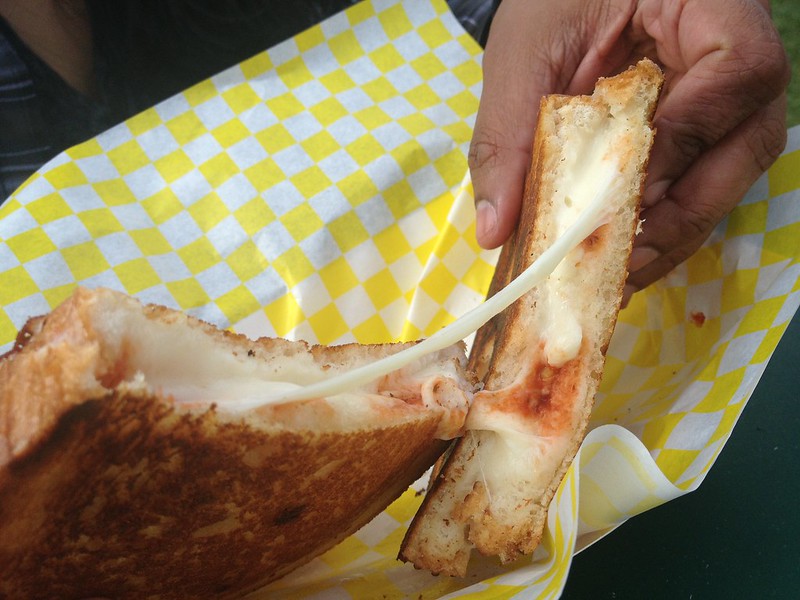 |
| Grilled Cheeza with marinara sauce |
In addition to serving up cheesy goodness, Emily is also the President of the Cincinnati Food Truck Association, which helps with advancements in organization and city involvement with the Queen City's squad of 23+ food trucks.
C'est Cheese is out and about in the tri-state all week long and is available for private catering. Keep an eye out for this delightful food bus rolling into a neighborhood near you!
STREETCAR SOCIAL
Regardless of what side you're on, one question in the forefront of everyone's mind is: "What's going on with the Cincinnati Streetcar?"
To help keep people updated on current events, Cincinnatians For Progress hosted their first Streetcar Social at The Lackman. Over 70 guests attended for discussion and drinks with streetcar advocate, John Schneider, and information sharing with those wanting to learn more. Among those in attendance were Cincinnati City Council candidate Mike Moroski, and campaign managers representing Councilmembers Chris Seelbach and Yvette Simpson.
This spring, City Manager Milton Dohoney announced that the project would need an additional $17 million to proceed due to inflation. Two failed ballot initiatives meant to derail the Cincinnati Streetcar, and the revocation of $51 million from the State of Ohio's TRAC have delayed the project for years and contributed to the increased cost.
While it is understandable to not award any project a blank check, the consequence of failing to invest $17 million in the Cincinnati Streetcar is having to lose $72 million in funds already spent, including Federal funds that have been allocated to Cincinnati. Additionally, the city would lose a Net Profit Value of $200 million in future opportunities that the streetcar would generate through development.
For more on what's at stake, check out this article on UrbanCincy.com or watch a video of the presentation that Milton Dohoney gave to City Council:
Some interesting talking points highlighted at the Streetcar Social included:
- No modern streetcar system has ever failed. In fact, every new streetcar system has added expansions in the past two years.
- Why can't we just buy a bunch of buses? Rail-based transportation cannot easily be moved. Neither can I-75 or the street in front of your house. The community value of transportation improvement is its permanence, not its flexibility. It represents investment.
- Streetcar bonds will be paid off with property taxes from higher values in the streetcar zone. New revenue based on payroll tax, sales tax, and local spending from thousands of new residents will be shared across all of Cincinnati's 52 neighborhoods.
- Streetcars promote repopulation. According to the last census, Cincinnati was losing eight residents a day. Fewer people means less taxpayers, which contributes to the city's budget deficit. In Tacoma, Seattle, and Portland, these cities' starter streetcar lines grew the population by an average of 47% between 2001 and 2010.
- If Cincinnati were to abandon the streetcar, the city may be viewed as an unreliable partner of the U.S. Department of Transportation. This could have minor implications for the new Brent Spence Bridge, and major implications for improving our bus system using Federal funds. It could also affect Cincinnati's chances of applying for federal funds with HUD and the EPA.
- Cincinnati is the only city in the Top 41 metropolitan areas in the U.S. that does not have rail transit. If the city were to walk away from the streetcar project now, it is likely that we will not implement light rail for another generation, thus putting us behind other cities in similar size and competitive nature.
Interested in staying up to date on the Cincinnati Streetcar? Follow Cincinnatians For Progress on Twitter and Facebook, or support them by making a donation to their non-profit organization.
To help keep people updated on current events, Cincinnatians For Progress hosted their first Streetcar Social at The Lackman. Over 70 guests attended for discussion and drinks with streetcar advocate, John Schneider, and information sharing with those wanting to learn more. Among those in attendance were Cincinnati City Council candidate Mike Moroski, and campaign managers representing Councilmembers Chris Seelbach and Yvette Simpson.
This spring, City Manager Milton Dohoney announced that the project would need an additional $17 million to proceed due to inflation. Two failed ballot initiatives meant to derail the Cincinnati Streetcar, and the revocation of $51 million from the State of Ohio's TRAC have delayed the project for years and contributed to the increased cost.
While it is understandable to not award any project a blank check, the consequence of failing to invest $17 million in the Cincinnati Streetcar is having to lose $72 million in funds already spent, including Federal funds that have been allocated to Cincinnati. Additionally, the city would lose a Net Profit Value of $200 million in future opportunities that the streetcar would generate through development.
For more on what's at stake, check out this article on UrbanCincy.com or watch a video of the presentation that Milton Dohoney gave to City Council:
Some interesting talking points highlighted at the Streetcar Social included:
- No modern streetcar system has ever failed. In fact, every new streetcar system has added expansions in the past two years.
- Why can't we just buy a bunch of buses? Rail-based transportation cannot easily be moved. Neither can I-75 or the street in front of your house. The community value of transportation improvement is its permanence, not its flexibility. It represents investment.
- Streetcar bonds will be paid off with property taxes from higher values in the streetcar zone. New revenue based on payroll tax, sales tax, and local spending from thousands of new residents will be shared across all of Cincinnati's 52 neighborhoods.
- Streetcars promote repopulation. According to the last census, Cincinnati was losing eight residents a day. Fewer people means less taxpayers, which contributes to the city's budget deficit. In Tacoma, Seattle, and Portland, these cities' starter streetcar lines grew the population by an average of 47% between 2001 and 2010.
- If Cincinnati were to abandon the streetcar, the city may be viewed as an unreliable partner of the U.S. Department of Transportation. This could have minor implications for the new Brent Spence Bridge, and major implications for improving our bus system using Federal funds. It could also affect Cincinnati's chances of applying for federal funds with HUD and the EPA.
- Cincinnati is the only city in the Top 41 metropolitan areas in the U.S. that does not have rail transit. If the city were to walk away from the streetcar project now, it is likely that we will not implement light rail for another generation, thus putting us behind other cities in similar size and competitive nature.
Interested in staying up to date on the Cincinnati Streetcar? Follow Cincinnatians For Progress on Twitter and Facebook, or support them by making a donation to their non-profit organization.
RUMPKE LANDFILL TOUR
In celebration of National Garbage Man Day, fellow blogger Adventure Mom and I ventured to Colerain to learn about where our garbage goes. Free and open to the public, Rumpke gives tours of its landfill to over 10,000 visitors annually.
Rumpke stems from humble beginnings in 1932, when coal delivery man, William Rumpke would accept livestock as trade for his services. One day, he was paid with six pigs to which he began feeding garbage. By the 1950s, William owned over 1,000 animals and people had begun paying him cash to remove their trash. The site of Rumpke's landfill is on the original property used by William for his farm. Today, the business has expanded to include 2,000 employees, nine addidtional landfills and ten recycling centers.
Over 800 truck loads of garbage are delivered daily to Rumpke from within a 60-mile radius. That equals out to 8,000 tons of trash per day collected from two million citizens. Some of the more interesting things that have discarded in Rumpke Landfill include a circus elephant, the world's largest chocolate bar, dentures (that the owner later retrieved), and church donation envelopes filled with money.
Naturally, Adventure Mom and I chose the hottest day of the year to visit Rumpke, which left us wondering if it would make for a rather "ripe" experience. We didn't smell a thing during our tour. Rumpke uses organic air fresheners that look like orange rope, which surrounds the perimeter of each hole to control the scent. They also has an industrial strength Febreeze-like sprayer that mists the garbage if things get a little rank. I never thought a landfill would smell as fresh as a daisy!
A working day for a garbage man begins at 3:30am and lasts until noon. One residential truck can hold trash from up to 500 households, while a commercial dumpster truck can hold 80 stops worth of waste. One garbage truck costs $250,000.
When arriving at the facility, garbage trucks are weighed at a weigh station and tracked to know where each load came from. From there, the trucks proceed to dump their load into a big hole, called a cell. Each cell contains a three-foot layer of clay with special liners which act like concrete to keep water and materials inside. Any runoff from the garbage is collected and set to a waste water treatment plant.
After dumping their load, garbage trucks proceed through the wheel washer to become sanitized after leaving the landfill.
Additionally, methane gas that the garbage produces is collected and recycled. Energy from the gasses are used to power 7% of the Duke Energy customers' homes, benefiting 25,000 residences. It is also used to fuel 30 Rumpke trucks as an alternative to diesel.
We we victoriously scaled to the top of "Mount Rumpke," one can see for miles atop this 150-foot hill.
Over 60% of the waste that is dumped in the Rumpke Landfill could be recycled. The current land is only sustainable for another 12 years until it reaches capacity. Fortunately, staff is working on an expansion that will add another 40-year lifespan. Each "giant hole" is approximately 150 feet deep and several football fields in length. Each new cell will be completely filled with trash within three years.
After Rumpke's landfill reaches capacity, it will be covered with a hygienic liner, grass will be planted, and the space will transform into a park. Is this safe? Absolutely. The site will continue to be monitored for groundwater and air quality for 30 years after Rumpke ends is reign.
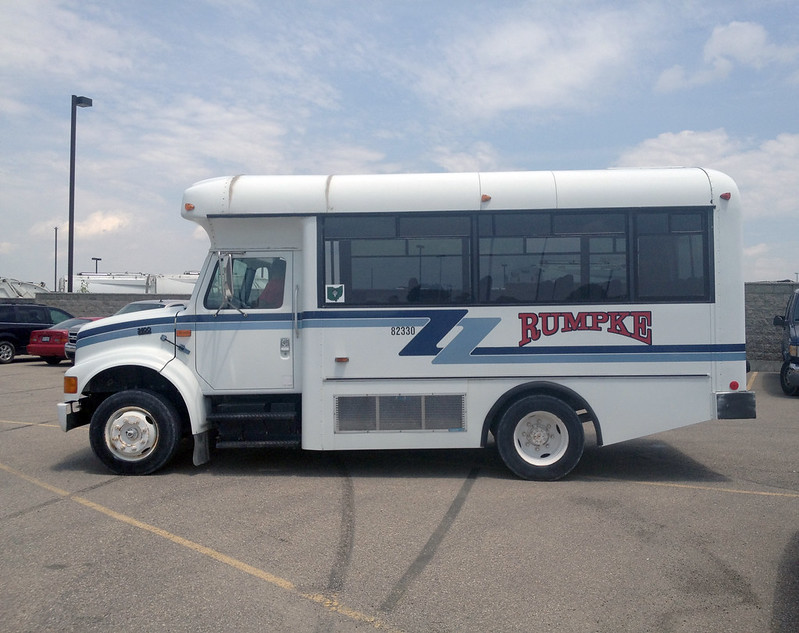 |
| Our tour bus |
 |
| Excited young visitors joined us for the Rumpke tour |
Rumpke stems from humble beginnings in 1932, when coal delivery man, William Rumpke would accept livestock as trade for his services. One day, he was paid with six pigs to which he began feeding garbage. By the 1950s, William owned over 1,000 animals and people had begun paying him cash to remove their trash. The site of Rumpke's landfill is on the original property used by William for his farm. Today, the business has expanded to include 2,000 employees, nine addidtional landfills and ten recycling centers.
Over 800 truck loads of garbage are delivered daily to Rumpke from within a 60-mile radius. That equals out to 8,000 tons of trash per day collected from two million citizens. Some of the more interesting things that have discarded in Rumpke Landfill include a circus elephant, the world's largest chocolate bar, dentures (that the owner later retrieved), and church donation envelopes filled with money.
Naturally, Adventure Mom and I chose the hottest day of the year to visit Rumpke, which left us wondering if it would make for a rather "ripe" experience. We didn't smell a thing during our tour. Rumpke uses organic air fresheners that look like orange rope, which surrounds the perimeter of each hole to control the scent. They also has an industrial strength Febreeze-like sprayer that mists the garbage if things get a little rank. I never thought a landfill would smell as fresh as a daisy!
A working day for a garbage man begins at 3:30am and lasts until noon. One residential truck can hold trash from up to 500 households, while a commercial dumpster truck can hold 80 stops worth of waste. One garbage truck costs $250,000.
When arriving at the facility, garbage trucks are weighed at a weigh station and tracked to know where each load came from. From there, the trucks proceed to dump their load into a big hole, called a cell. Each cell contains a three-foot layer of clay with special liners which act like concrete to keep water and materials inside. Any runoff from the garbage is collected and set to a waste water treatment plant.
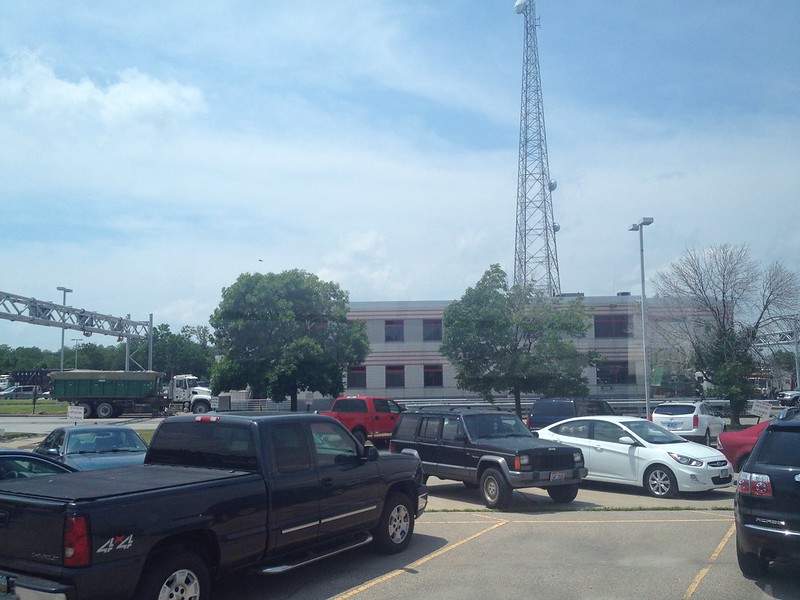 |
| Weigh station |
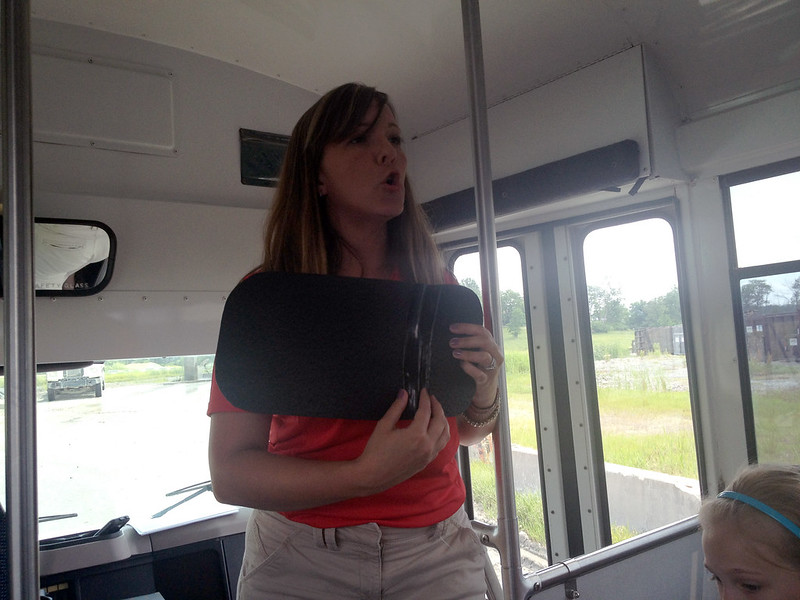 |
| Our guide, Sara, explains the different types of liners for the garbage cells. |
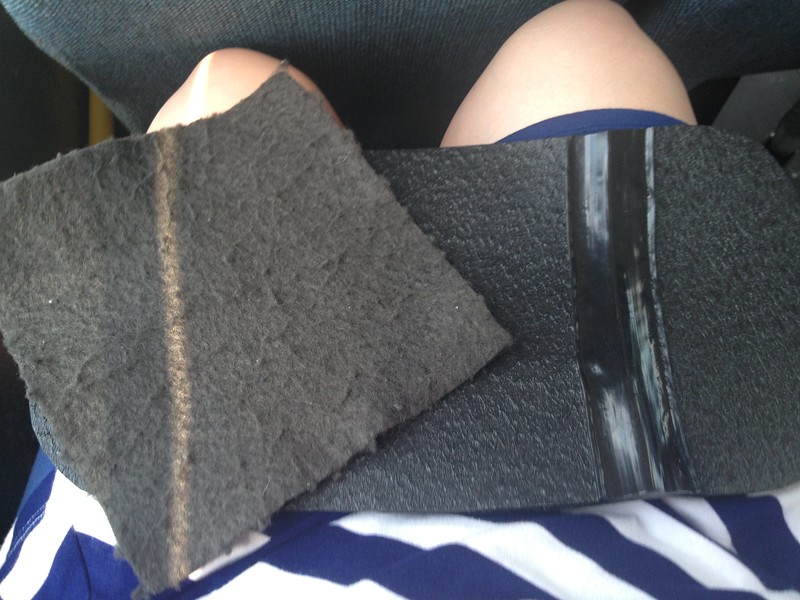 |
| Samples of the liners in the landfill |
After dumping their load, garbage trucks proceed through the wheel washer to become sanitized after leaving the landfill.
Additionally, methane gas that the garbage produces is collected and recycled. Energy from the gasses are used to power 7% of the Duke Energy customers' homes, benefiting 25,000 residences. It is also used to fuel 30 Rumpke trucks as an alternative to diesel.
We we victoriously scaled to the top of "Mount Rumpke," one can see for miles atop this 150-foot hill.
 |
| Ascending Mount Rumpke. Check out that view! |
 |
| Made it to the top! |
Over 60% of the waste that is dumped in the Rumpke Landfill could be recycled. The current land is only sustainable for another 12 years until it reaches capacity. Fortunately, staff is working on an expansion that will add another 40-year lifespan. Each "giant hole" is approximately 150 feet deep and several football fields in length. Each new cell will be completely filled with trash within three years.
After Rumpke's landfill reaches capacity, it will be covered with a hygienic liner, grass will be planted, and the space will transform into a park. Is this safe? Absolutely. The site will continue to be monitored for groundwater and air quality for 30 years after Rumpke ends is reign.
 |
| Regrowth of green space on the previously filled garbage cells. |
HOXWORTH'S RIGHT TYPE PARTY
One of the largest and most-attended blood drives of the year takes place at Great American Ball Park, as Hoxworth Blood Center partners with the Cincinnati Reds. This year, the spokesman for Hoxworth is none other than Marty Brennaman, long-time announcer for the Reds. To kick off the event, Montgomery Inn Boathouse hosted a meet-and-greet with Marty and other influential people dedicated to saving lives.
Hoxworth serves 17 counties throughout the tri-state, and is responsible for collecting, testing, processing and distributing blood to 31 local hospitals. In order to meet the needs of patients, 400 volunteer blood donors and 40 platelet donors are needed each day to keep the supply bountiful.
The Annual Reds Blood Drive is equipped to handle donors en mass, and also offers incentives for those who come down to the ballpark. Donors receive a free Cincinnati Reds tee shirt, Marty paddle fan, and a pair of tickets to a Reds game. Over 500 people have already signed up to take part in this charitable event.
Giving blood takes less ten minutes and is relatively painless. Here are some cool facts I learned from the staff at Hoxworth at their event:
- There are four main types of blood A, B, AB and O. Each can be positive or negative. AB is the universal recipient; O negative is the universal donor of red blood cells.
- Only 37 percent of the U.S. population is eligible to donate blood – less than 10 percent do annually.
- Someone needs blood every two seconds.
- One pint of a donor's blood can save up to three lives.
- Healthy adults are able to donate one pint of blood every two months.
One of the oldest blood centers in the country, Hoxworth was founded in December 1938 by a Cincinnati surgeon, Dr. Paul I. Hoxworth. It originated as a one-room laboratory with peak demand during World War II, and has since transformed into a state-of-the-art facility with eight donor centers.
The Annual Reds Blood Drive takes place on June 13 from 10:00AM - 7:00PM.
Reds Week will be celebrated from June 10 - 15 at all neighborhood donor centers. Donors at these locations will receive a free Cincinnati Reds shirt for their contribution.
 |
| Dean Gregory, owner of Montgomery Inn |
 |
| Marty Brennaman speaks about Hoxworth and baseball |
 |
| Marty and I sporting the Marty paddle fan giveaways. |
Hoxworth serves 17 counties throughout the tri-state, and is responsible for collecting, testing, processing and distributing blood to 31 local hospitals. In order to meet the needs of patients, 400 volunteer blood donors and 40 platelet donors are needed each day to keep the supply bountiful.
 |
| This 7-year-old was born with a rare form of anemia, and relies on Hoxworth to receive 13 transfusions a year. |
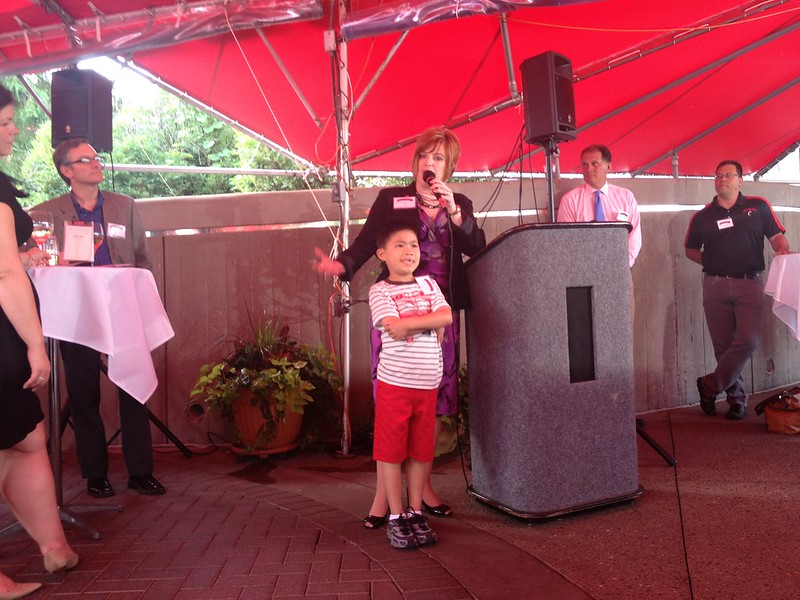 |
| His mother tells their story and their gratitude to Hoxworth. |
The Annual Reds Blood Drive is equipped to handle donors en mass, and also offers incentives for those who come down to the ballpark. Donors receive a free Cincinnati Reds tee shirt, Marty paddle fan, and a pair of tickets to a Reds game. Over 500 people have already signed up to take part in this charitable event.
Giving blood takes less ten minutes and is relatively painless. Here are some cool facts I learned from the staff at Hoxworth at their event:
- There are four main types of blood A, B, AB and O. Each can be positive or negative. AB is the universal recipient; O negative is the universal donor of red blood cells.
- Only 37 percent of the U.S. population is eligible to donate blood – less than 10 percent do annually.
- Someone needs blood every two seconds.
- One pint of a donor's blood can save up to three lives.
- Healthy adults are able to donate one pint of blood every two months.
 |
| Hoxworth staff looks on at the event. |
One of the oldest blood centers in the country, Hoxworth was founded in December 1938 by a Cincinnati surgeon, Dr. Paul I. Hoxworth. It originated as a one-room laboratory with peak demand during World War II, and has since transformed into a state-of-the-art facility with eight donor centers.
The Annual Reds Blood Drive takes place on June 13 from 10:00AM - 7:00PM.
Reds Week will be celebrated from June 10 - 15 at all neighborhood donor centers. Donors at these locations will receive a free Cincinnati Reds shirt for their contribution.
Subscribe to:
Posts (Atom)




